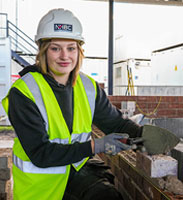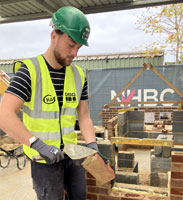Existing Smaller NHBC Training Hub
NHBC invests £100M in Multi-Skills Training Hubs to tackle UK house-building skills shortage
As part of the government’s plans announced this morning to get Britain building again, the National House Building Council (NHBC) is supercharging the UK house-building industry with the launch of the first 12 new multi-skills training hubs, backed by its £100 million investment.
The new national network of NHBC Multi-Skills Training Hubs will address the house-building industry’s growing skills shortage by producing an additional 3,000 skilled and site-ready tradespeople faster each year.
As the UK’s leading independent provider of warranty and insurance for new-build homes, NHBC is committed to closing the skills gap in the house-building industry with the launch of its new training hubs. These expert facilities will initially provide training in areas of critical demand for housebuilding, including bricklaying, groundwork and site carpentry. They are designed to stay flexible however, ready to adapt to local housing needs and changes in regulations.
Roger Morton, Director of Change and Training Hubs at NHBC, commented:
“We’re not just training apprentices, we’re shaping the future of UK house building. With 25 years as an officer in the Royal Engineers, I’m driven by navigating challenges and improving quality. NHBC’s multi-skills hubs will shake up house-building training, tackling the skills shortage head-on and making a real difference to the future of the industry. Our multi-skills hubs will have a significant impact, producing skilled tradespeople faster and who are ready to hit the ground running from day one. Our mission is to make sure every apprentice meets NHBC’s high standards, guaranteeing quality and delivering the homes the UK urgently needs, when and where they’re needed.
“With competitive salaries for qualified tradespeople, NHBC’s Multi-Skills Training Hubs offer a faster, diverse and rewarding pathway into the house-building industry. Thanks to funding support through the Apprenticeship Levy and generous grants, there’s never been a better time for builders and contractors to invest in taking on apprentices and for people to start a rewarding career in this essential industry.”
NHBC’s Multi-Skills Hubs stand apart by immersing apprentices in real-site conditions from day one, fully preparing them for life on site. While traditional training routes can take up to 30 months, NHBC’s fast-track approach enables apprentices to complete their training in just 14 to 18 months – nearly twice as fast as other more traditional programmes – with many graduates achieving distinctions.
Alice Clay, 19, from Patrington, Hull and a brickwork apprentice trained by NHBC, praised the initiative:
“The NHBC Multi-Skills Training Hubs are going to make a real difference! It’s really appealing to apprentices and builders because these hubs will be training skilled tradespeople faster than ever, giving a huge boost to getting more quality homes built across the UK.
“I was the first woman to pass my NHBC Bricklaying apprenticeship and I achieved a distinction! I knew I wanted a practical job and within weeks of joining the NHBC training programme, I felt confident and capable on site. There’s a lot to learn, but training at an NHBC hub meant I was working in real-site conditions from day one. I’d learn at the hub and then regularly put my new skills and knowledge into practice out on site. The training NHBC offers is of a gold standard. It’s well-respected, hands-on and fast-paced. It’s exactly what the industry needs.”
NHBC’s Multi-Skills Training Hubs will help meet industry demands for faster, more flexible and practical training to support UK house builders in meeting the government’s target of 1.5 million new homes over the next five years. The initiative is especially timely, as the UK faces an urgent need for skilled workers, with estimates showing over 250,000 new construction workers will be needed by 2028 to meet industry demand.
Ben Thorburn, 23, a Bricklaying Apprentice from Histon, Cambridgeshire, with GSQ Brickwork at the NHBC Training Hub in Cambridge, shared:
“NHBC’s new multi-skills hubs are a fantastic initiative! They’re going to transform how the UK trains its house-building workforce. Training with NHBC means I’m gaining the best industry recognised qualification quickly. It’s only going to take me 15 months to complete my apprenticeship. That’s half the time of other Further Education options. That’s crucial when you have financial responsibilities like I do. I wouldn’t have been able to afford the time otherwise.
“NHBC’s Training Hubs also have a big appeal for the subcontractor I work for because I’m on site faster and fully qualified to industry-leading standards. My company can build a team of skilled tradespeople, quickly. Alongside the support of the Apprenticeship Levy builders can get, the new hubs mean it’s a win-win for everyone.
“Looking ahead, the housebuilding industry offers amazing career prospects. Once I qualify in January, I’ll be on track to earn an average of around £50,000 a year. I was discouraged from doing an apprenticeship at school and my teachers pushed me towards university as the only real option. After my A-Levels, I realised a desk job wasn’t for me. There’s a misconception that bricklayers aren’t academic, but that’s just not true. I’m proof that you can build a successful career in housebuilding through an apprenticeship and I’m aiming to move into a management role down the line.”
With funding support from the Apprenticeship Levy and other grants, NHBC’s apprenticeships are an attractive option for builders and contractors of all sizes looking to develop and grow a skilled workforce, and individuals considering a rewarding career path in house building.
Tegan Pryor, 22 from Shefford in Bedfordshire and an apprentice at the NHBC Training Hub in Cambridge said she struggled to find a bricklaying apprenticeship:
“We need more houses, but we also need more small and medium-sized builders to take on apprentices. I was really surprised by how difficult it was to secure an apprenticeship, as there simply weren’t enough opportunities in the house-building industry and competition was fierce for the few available spots. Eventually, I secured an apprenticeship with Redrow and with NHBC’s training, I’ll qualify in just 15 months. Soon I’ll be out on site earning a great wage and knowing exactly what to expect as I’ve been trained in real site conditions by NHBC’s expert trainers.
“I know the new multi-skills training hubs will make a big difference in local communities. I’d encourage builders and contractors to invest in the future by taking on apprentices like me. Together, we can grow a skilled workforce that will help close the industry’s skills gap and deliver the quality homes we need.”
NHBC is currently evaluating prospective locations for its new Multi-Skills Training Hubs across the UK, with plans for its first hub to launch in early 2025 and 11 more to follow at pace.
CLICK HERE For more information




 “We’re not just training apprentices, we’re shaping the future of UK house building. With 25 years as an officer in the Royal Engineers, I’m driven by navigating challenges and improving quality. NHBC’s multi-skills hubs will shake up house-building training, tackling the skills shortage head-on and making a real difference to the future of the industry. Our multi-skills hubs will have a significant impact, producing skilled tradespeople faster and who are ready to hit the ground running from day one. Our mission is to make sure every apprentice meets NHBC’s high standards, guaranteeing quality and delivering the homes the UK urgently needs, when and where they’re needed.
“We’re not just training apprentices, we’re shaping the future of UK house building. With 25 years as an officer in the Royal Engineers, I’m driven by navigating challenges and improving quality. NHBC’s multi-skills hubs will shake up house-building training, tackling the skills shortage head-on and making a real difference to the future of the industry. Our multi-skills hubs will have a significant impact, producing skilled tradespeople faster and who are ready to hit the ground running from day one. Our mission is to make sure every apprentice meets NHBC’s high standards, guaranteeing quality and delivering the homes the UK urgently needs, when and where they’re needed. “The NHBC Multi-Skills Training Hubs are going to make a real difference! It’s really appealing to apprentices and builders because these hubs will be training skilled tradespeople faster than ever, giving a huge boost to getting more quality homes built across the UK.
“The NHBC Multi-Skills Training Hubs are going to make a real difference! It’s really appealing to apprentices and builders because these hubs will be training skilled tradespeople faster than ever, giving a huge boost to getting more quality homes built across the UK. “NHBC’s new multi-skills hubs are a fantastic initiative! They’re going to transform how the UK trains its house-building workforce. Training with NHBC means I’m gaining the best industry recognised qualification quickly. It’s only going to take me 15 months to complete my apprenticeship. That’s half the time of other Further Education options. That’s crucial when you have financial responsibilities like I do. I wouldn’t have been able to afford the time otherwise.
“NHBC’s new multi-skills hubs are a fantastic initiative! They’re going to transform how the UK trains its house-building workforce. Training with NHBC means I’m gaining the best industry recognised qualification quickly. It’s only going to take me 15 months to complete my apprenticeship. That’s half the time of other Further Education options. That’s crucial when you have financial responsibilities like I do. I wouldn’t have been able to afford the time otherwise. “We need more houses, but we also need more small and medium-sized builders to take on apprentices. I was really surprised by how difficult it was to secure an apprenticeship, as there simply weren’t enough opportunities in the house-building industry and competition was fierce for the few available spots. Eventually, I secured an apprenticeship with Redrow and with NHBC’s training, I’ll qualify in just 15 months. Soon I’ll be out on site earning a great wage and knowing exactly what to expect as I’ve been trained in real site conditions by NHBC’s expert trainers.
“We need more houses, but we also need more small and medium-sized builders to take on apprentices. I was really surprised by how difficult it was to secure an apprenticeship, as there simply weren’t enough opportunities in the house-building industry and competition was fierce for the few available spots. Eventually, I secured an apprenticeship with Redrow and with NHBC’s training, I’ll qualify in just 15 months. Soon I’ll be out on site earning a great wage and knowing exactly what to expect as I’ve been trained in real site conditions by NHBC’s expert trainers.





